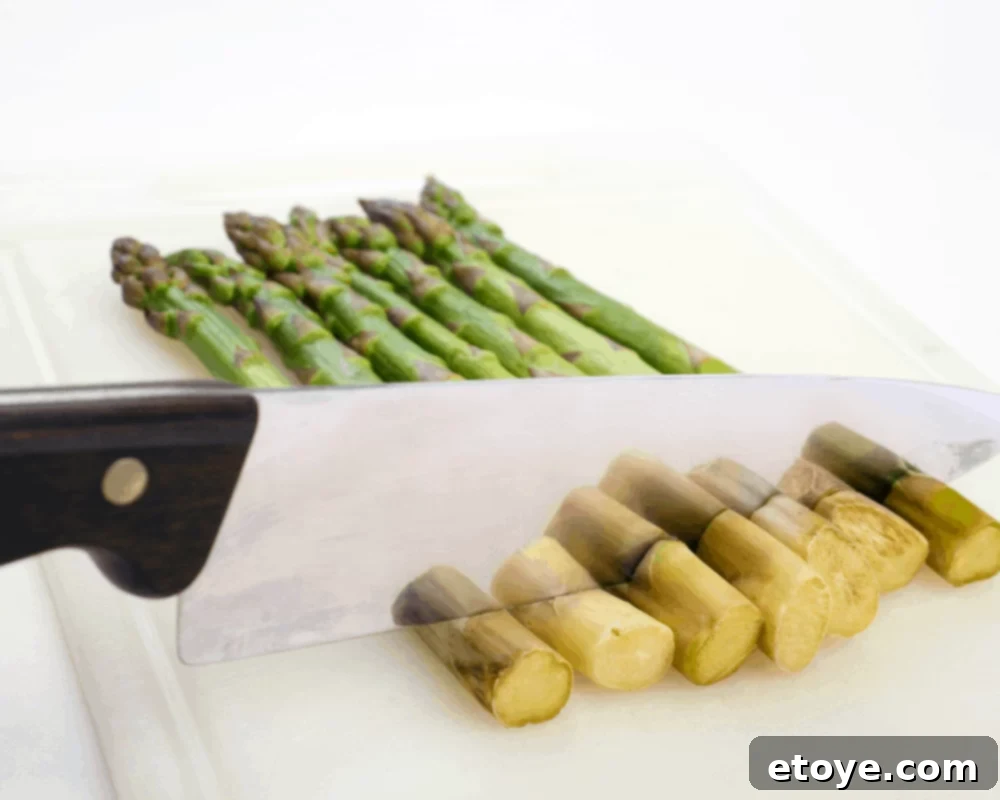Navigating the produce aisle can sometimes feel like a culinary challenge, especially when faced with a sea of similar-looking greens. But fear not, because by the end of this comprehensive guide, you’ll be an absolute pro at selecting, storing, and enjoying fresh asparagus. This versatile and delicious vegetable is a true kitchen hero, and understanding its nuances will elevate your meals to new heights.

Discovering Asparagus for Your Buddha Bowls

Buddha Bowls have become a staple in healthy eating, offering a vibrant and nutritious way to enjoy a balanced meal. These customizable bowls are typically composed of a grain base, a protein source, a variety of fresh vegetables, and a flavorful dressing. Asparagus, with its delightful crunch and distinct earthy flavor, is an ideal addition to any Buddha Bowl. Its appealing texture and bright green color not only enhance the visual appeal of your bowl but also contribute a wealth of nutrients, making your meal both delicious and incredibly wholesome.
Incorporating fresh asparagus into your Buddha Bowls is a fantastic way to add both flavor and essential nutrients without breaking the bank. Asparagus is a seasonal vegetable, often more affordable and flavorful when purchased during its peak season, typically from spring to early summer. Knowing how to choose the freshest stalks and store them properly means you’ll always have this amazing ingredient ready to transform your meals. We’re about to delve into the secrets of selecting the best asparagus at the grocery store and the most effective methods for keeping it fresh and crisp, ensuring every bite in your Buddha Bowl is a testament to quality and taste.
Why Asparagus is an Unbeatable Addition to Your Diet
Asparagus isn’t just a pretty face in the vegetable world; it’s a nutritional powerhouse packed with health benefits and culinary versatility. Here’s why this green stalk deserves a permanent spot on your plate:
- A Delicious and Healthy Crunchy Option: Asparagus offers a satisfying bite and a unique flavor profile that complements a wide array of dishes. It’s low in calories, making it an excellent choice for health-conscious eaters seeking flavorful, guilt-free additions to their meals. Its slight bitterness, when cooked correctly, adds a sophisticated note that elevates even simple preparations.
- Effortless Cooking, Even in the Microwave! Asparagus is incredibly simple to prepare, making it perfect for quick weeknight dinners or busy meal prep sessions. Whether you prefer steaming it for a tender-crisp texture, roasting it for a caramelized sweetness, grilling it for a smoky char, or sautéing it with garlic and olive oil, asparagus cooks quickly and beautifully. The microwave method, as highlighted, is a fantastic option when time is of the essence, delivering perfectly steamed spears in minutes.
- A Rich Source of Essential Nutrients: Beyond its taste and ease of preparation, asparagus is a nutritional superstar. It’s particularly high in folate (Vitamin B9), which is crucial for cell growth and DNA formation. It also provides a significant amount of Vitamin K, essential for blood clotting and bone health, and Vitamin A, which supports vision and immune function. Furthermore, asparagus is a good source of dietary fiber, promoting digestive health, and contains various antioxidants that help protect your body from harmful free radicals.
- Impressive Shelf Life When Stored Correctly: One of the often-underestimated benefits of asparagus is its ability to stay fresh in the refrigerator for up to a week, provided you use the right storage techniques. This makes it a convenient vegetable to stock up on, ensuring you always have a healthy option readily available for impromptu meals or planned cooking. Proper storage not only extends its life but also maintains its crisp texture and vibrant flavor.
Mastering Asparagus Selection at the Grocery Store
The key to enjoying truly delicious asparagus begins with selecting the freshest stalks at the grocery store. A few simple visual and tactile tests can tell you everything you need to know about its quality and freshness. Armed with these tips, you’ll consistently pick the best of the bunch:
When you’re at the store, begin by visually inspecting the asparagus. Look for stalks that boast a vibrant, rich green color. While a slight hint of white or purple at the very bottom is normal and acceptable, any extensive yellowing or discoloration further up the stalk is a clear indicator of age. The green should be deep and consistent, suggesting that the vegetable has been recently harvested and properly handled.
Next, perform the “stand-up test.” Hold a bunch of asparagus horizontally. Truly fresh stalks will stand up straight and firm, resisting gravity with a noticeable rigidity. If the stalks appear limp, droopy, or bend easily when held, they are likely old and have lost a significant amount of their moisture content. Firmness is paramount for crispness and flavor.
Pay close attention to the tips, also known as the spears or buds. The tops of fresh asparagus should be tightly closed, compact, and firm to the touch. Avoid any asparagus stalks where the spears are beginning to open up, appear frayed, or have a slimy texture. Open or wilting tips are a tell-tale sign that the asparagus is past its prime and will likely be fibrous or woody when cooked.
Another crucial indicator of freshness lies in the cut ends of the stalks. Take a moment to examine the very bottom of an asparagus stalk. If the center of the cut end is milky white, almost translucent, and appears moist, you’ve found fresh asparagus. This moist, bright appearance signifies that the stalk is still full of hydration and vitality.
Conversely, if the cut end of the asparagus stalk has a hard, very white, dry, or even slightly woody center, it’s a strong indication that the asparagus is old. This dryness suggests that the stalk has been sitting for too long and has begun to dehydrate, leading to a tough, stringy, and less flavorful eating experience. You might also notice a slight browning or darkening around the edges of the cut if it’s older.
Finally, avoid any asparagus that appears dull, wrinkled, or feels rubbery when picked up. These are all signs of dehydration and age. While it might be tempting to buy slightly older asparagus at a discounted price, the compromise in taste and texture is rarely worth it. Investing in fresh, high-quality asparagus ensures a superior culinary experience every time.
The Ultimate Guide to Storing Asparagus for Maximum Freshness
Once you’ve carefully selected your perfect bundle of asparagus, proper storage is crucial to maintaining its crispness, flavor, and nutritional value for as long as possible. The goal is to keep the stalks hydrated and cool, mimicking their natural growing environment. Here’s the most effective method, along with a few tips to ensure your asparagus stays pristine for up to a week:
- Prepare Your Hydration Station: Start by finding a sturdy glass jar, a tall drinking glass, or a measuring cup. Fill it with about one to two inches of fresh, cold water. This water acts as a lifeline for your asparagus, allowing the stalks to absorb moisture and stay plump, much like a bouquet of cut flowers.
- Bundle and Trim for Optimal Absorption: Before placing them in water, gather your asparagus stalks into a neat bundle. You can secure them loosely with kitchen twine or a rubber band to keep them upright and organized. Next, take a sharp knife and carefully trim about an inch off the very bottom of the white, woody ends of the asparagus stalks. This fresh cut opens up the vascular system of the asparagus, allowing it to more readily absorb water, significantly extending its freshness. Discard the trimmed ends, as they tend to be tough and fibrous.
- Refrigerate and Protect: Carefully stand the bundled and trimmed asparagus spears upright in the prepared glass of water. Ensure that the cut ends are submerged. To protect the asparagus from drying out further and to prevent it from absorbing refrigerator odors, loosely cover the top of the bundle with a plastic bag (a produce bag works perfectly) or plastic wrap. This creates a mini-greenhouse effect, locking in moisture. Place the entire setup—glass and covered asparagus—in the refrigerator. Stored this way, your asparagus can remain wonderfully fresh and crisp for up to a week, sometimes even longer, eagerly awaiting its transformation into a delicious meal.

Beyond the Basics: Cooking and Enjoying Asparagus
With your perfectly selected and stored asparagus, the culinary possibilities are endless. Its delicate flavor pairs well with a multitude of ingredients and cooking methods. For a quick and healthy side dish, a simple roast with olive oil, salt, and pepper can bring out its natural sweetness. Grilling adds a lovely smoky char, while sautéing with garlic and lemon zest offers a bright, fresh taste. Asparagus also shines in more complex dishes, such as frittatas, pasta primavera, or creamy risottos. Its versatility makes it a perfect companion for spring meals, adding elegance and nutrition to any plate.
Consider incorporating asparagus into stir-fries for added crunch, or blanch it briefly and chill it for a refreshing addition to salads. For a luxurious touch, wrap asparagus spears in prosciutto and bake until crisp. The key is not to overcook it; asparagus is best when it retains a slight al dente bite. Overcooked asparagus can become mushy and lose its vibrant color. Experiment with different spices and herbs to discover your favorite combinations, from a sprinkle of Parmesan cheese to a drizzle of balsamic glaze.
Conclusion: Your Journey to Asparagus Mastery
By now, you should feel confident in your ability to choose the freshest asparagus at the market and store it in a way that preserves its peak quality. Mastering these fundamental techniques ensures that you always have access to this healthy and delicious vegetable, ready to be transformed into countless culinary delights, from simple steamed sides to intricate Buddha Bowls. Asparagus is a testament to the fact that healthy eating can be both effortless and incredibly flavorful.
We hope you found this guide to asparagus selection and storage invaluable. If you’ve tried our Buddha Bowl basics, experimented with the storage tips, or perhaps discovered a new recipe on our blog that features this wonderful vegetable, we would absolutely love to hear from you! Please take a moment to rate this content and share your experiences, tips, or any questions you might have in the comments section below. Your feedback helps us grow and continue providing useful content for your culinary adventures!
